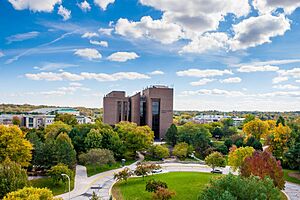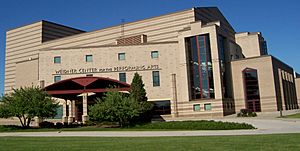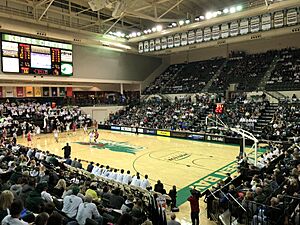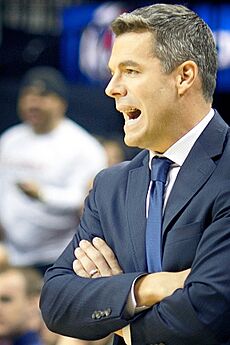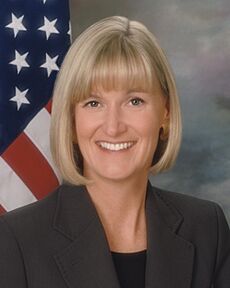University of Wisconsin–Green Bay facts for kids
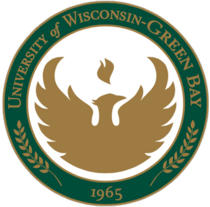 |
|
| Motto | Ad Scientiam Renovandam (Latin) |
|---|---|
|
Motto in English
|
"To Update Science" |
| Type | Public university |
| Established | 1965 |
|
Parent institution
|
University of Wisconsin System |
| Accreditation | HLC |
|
Academic affiliations
|
|
| Budget | $130 million |
| Chancellor | Michael Alexander |
| Students | 9,870 (all four campuses) |
| Undergraduates | 9,278 |
| Postgraduates | 592 |
| Location |
,
,
United States
44°31′48″N 87°55′15″W / 44.53°N 87.92083°W |
| Campus | Midsize city, 700 acres (2.8 km2) |
| Other campuses |
|
| Newspaper | The Fourth Estate |
| Colors | Green and white |
| Nickname | Phoenix |
|
Sporting affiliations
|
|
| Mascot | Phlash the Phoenix |
The University of Wisconsin–Green Bay (often called UW–Green Bay or UWGB) is a public university in Green Bay, Wisconsin. It was started in 1965 and is part of the University of Wisconsin System. As of fall 2024, over 11,000 students attend the school. This makes it the fastest-growing university in Wisconsin.
Since it began, the university has focused on protecting the environment. In 1971, Newsweek magazine even called it "Eco U." UW–Green Bay offers many different study programs. Students can earn associate, bachelor's, and master's degrees. There is also a special doctoral program called First Nations Ed.D. The university has other campuses in Marinette, Manitowoc, and Sheboygan, Wisconsin. The school's mascot is the phoenix, a mythical bird.
Contents
History of UW–Green Bay
By 1958, a smaller college center in Green Bay had grown quite a lot. It had 500 students and was the second-largest of its kind in Wisconsin. By 1965, it became the biggest. People in northeastern Wisconsin wanted a full four-year university.
In 1963, a committee suggested building a new university. Governor Warren Knowles then proposed that the Green Bay center become a four-year school. A similar plan was made for Kenosha, which became the University of Wisconsin–Parkside. The law to create UW–Green Bay was signed on September 2, 1965.
UW–Green Bay officially opened in the fall of 1968. Classes were first held at the Deckner Center. The university then moved to its current main location in the fall of 1969.
In 2018, the UW System changed how some schools were organized. UW–Green Bay took over three other two-year campuses. These became the UW–Green Bay Marinette, Sheboygan, and Manitowoc campuses. In January 2024, the Marinette campus moved all its classes online.
Exploring the UW–Green Bay Campus
The main campus is about 200 acres. It is on the northeast side of Green Bay, looking out over Lake Michigan's Green Bay. A large part of the campus is natural land. It is next to the bay on one side and the Niagara Escarpment on the other.
Circular roads go around the main part of campus. These are the main ways to get around. The Cofrin Memorial Arboretum is a natural area of 290 acres that surrounds the campus. It is a great place for fun, field trips, and research. The Arboretum helps protect Wisconsin's native plants and animals. It also lets people enjoy nature. There are more than six miles of trails open to everyone.
Main Campus Buildings
The David A. Cofrin Library is in the middle of campus. It is one of the tallest buildings in the Green Bay area. Near the library are all the main school buildings. These include the University Union, which is the student center. The Weidner Center for the Performing Arts is also nearby.
All the student dorms are in the northeast part of campus. Students can live in traditional dorm rooms or in apartments. The Richard Mauthe Center is a religious center for the campus. The Kress Events Center and sports fields are in the southeast part of campus. The university also has its own golf course, Shorewood Golf Course, to the north.
Across Nicolet Drive, there are two other university properties. These are Lambeau Cottage and Communiversity Park. Lambeau Cottage was once owned by Green Bay Packers founder Curly Lambeau. It is now used for university events. Communiversity Park is a small park next to the cottage, with views of the bay.
Campus Facilities
The Weidner Center for the Performing Arts has a large hall with 2,000 seats. It also has smaller rooms for recitals and a dance studio.
The Cofrin Library has over one million items. Its special collections include historical records of northeastern Wisconsin. The top floor of the library offers great views of the area.
The Kress Events Center is where the Phoenix sports teams play. It also hosts concerts and big university events. Students can work out, lift weights, and play intramural sports here. The center has a pool, courts for racquetball, and a climbing wall. There are also outdoor fields and a gym for basketball and volleyball.
Student Housing
UW–Green Bay has 28 buildings where students can live. These include traditional dorms and apartment-style housing. About 2,000 students live on campus.
Underground Tunnels
The main campus has a system of underground hallways. Students and staff call them "tunnels." These tunnels connect eleven buildings. The David A. Cofrin Library is at the center of this system. The tunnels help people get around campus easily, especially in bad weather. They also make the campus more accessible for everyone.
What Students Study at UW–Green Bay
Since 2016, the university has four main colleges:
- College of Arts, Humanities and Social Sciences
- Austin E. Cofrin School of Business
- College of Health, Education and Social Welfare
- College of Science, Engineering and Technology
The College of Arts, Humanities and Social Sciences offers the most majors. These include art, music, history, and social studies. It also has programs for communication and economics.
The Cofrin School of Business is named after Austin E. Cofrin, a kind person who helped the community. His son, David, gave money to start this school in 2010. It was the largest gift for a school program since the university began. This school offers majors like accounting and business.
The College of Health, Education and Social Welfare has programs for careers that help people. These include education, healthcare, and social work. It also works with the nearby Bellin College for nursing programs.
The College of Science, Engineering and Technology focuses on science and math. It also has an Engineering Technology program.
In 2021, the most popular majors for undergraduate students were business, psychology, and nursing. For graduate students, social work and sustainable management were very popular.
Student Life at UW–Green Bay
Students can get involved in how the university is run. They do this through the Student Government Association. This group has different parts, like an executive branch and a legislative branch.
There are over 100 student clubs on campus. These include groups for special interests, honor societies, and sports teams. There are also clubs for different careers and academic subjects.
Green Bay Phoenix Athletics
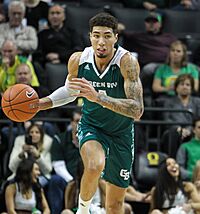
UW–Green Bay is known as "Green Bay" in sports. It is an NCAA Division I school. This means its sports teams compete at a high level. They are part of the Horizon League.
The Green Bay women's basketball team has been very successful. They have won or shared the Horizon League championship many times. The team has also played in the NCAA tournament twenty times. They have also played in the Women's National Invitation Tournament (WNIT) twice.
In 2003, the team was ranked nationally for the first time. They were as high as #16 in some polls. In 2011, they made it to the "Sweet Sixteen" in the NCAA tournament. This was a big achievement for the team.
The Green Bay softball team won its first Horizon League tournament in 2005. They then went to the national tournament. The Green Bay Women's Volleyball team won its first Horizon League title in 2018. They also played in the NCAA tournament that year.
Famous People from UW–Green Bay
Sports Stars
- Tony Bennett, a basketball player and coach.
- Alec Brown, a basketball player.
- Sandy Cohen, an American-Israeli basketball player.
- Alfonzo McKinnie, a basketball player.
- Rob Davis, an assistant coach for the Dallas Cowboys.
- Tosaint Ricketts, a Canadian soccer player.
Leaders and Educators
- Robert Cowles, a Wisconsin State Senator.
- Dave Hansen, a Wisconsin State Senator.
- Barbara Lawton, a former Lieutenant Governor of Wisconsin (she attended the university).
Entertainment
- Mike Grell, a comic book writer and artist.
- Tony Shalhoub, a famous actor (he attended but did not graduate).
- Kevin MacLeod, a composer and music producer (he attended but did not graduate).
Business Leaders
- Mark King, the CEO of Taco Bell.
Notable Teachers at UW–Green Bay
- Gregory S. Aldrete, a history professor.
- Herbert J. Grover, a Wisconsin educator and politician.
- Harvey J. Kaye, a professor of democracy studies.
- Denise Sweet, who was the Poet Laureate of Wisconsin from 2004 to 2008.
See also
 In Spanish: Universidad de Wisconsin-Green Bay para niños
In Spanish: Universidad de Wisconsin-Green Bay para niños


